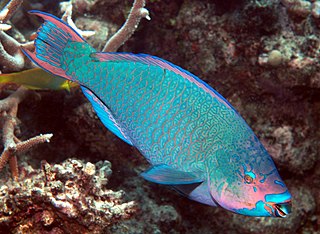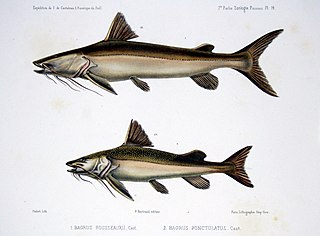
Mackerel is a common name applied to a number of different species of pelagic fish, mostly from the family Scombridae. They are found in both temperate and tropical seas, mostly living along the coast or offshore in the oceanic environment.
Corydoras ehrhardti is a tropical freshwater fish belonging to the Corydoradinae sub-family of the family Callichthyidae. It originates in coastal rivers in the Santa Catarina and Paraná states of Brazil from the Iguazu River basin.

Rineloricaria is a genus of freshwater tropical catfish belonging to the family Loricariidae. They are commonly called whiptail catfish because of the long filament that grows out of the tip of the caudal fin that is characteristic of the genus. With the exception of R. altipinnis from Panama, they are native to the rivers of northern and central South America. Some species are regularly seen in the aquarium trade.

Squalus altipinnis, the western highfin spurdog, is a dogfish of the family Squalidae found on the continental shelf off Western Australia, at depths between 220 and 510 m. Its reproduction is ovoviviparous.

The Heptapteridae, or three-barbeled catfishes, are a family of catfish that originate from the Americas. Most species are restricted to South America, but Imparfinis lineatus, Nemuroglanis panamensis and Pimelodella chagresi are native to Panama, and Rhamdia species occur as far north as Mexico. The name Heptapteridae is derived from Greek, hepta meaning seven and pteron meaning fin.
Parambassis altipinnis, commonly known as the high-finned glass perchlet, is a species of fish in the family Ambassidae. It is endemic to West Papua in Indonesia.

Pimelodella is a genus of three-barbeled catfishes.
Acentronichthys leptos is the only species of catfish in the genus Acentronichthys of the family Heptapteridae. This species occurs in coastal streams in Brazil from Rio de Janeiro to Santa Catarina State, in São Mateus, Espírito Santo State and on Leopoldina, Minas Gerais. This species grows to 9.1 cm (3.6 in) in SL.

Cavefish or cave fish is a generic term for fresh and brackish water fish adapted to life in caves and other underground habitats. Related terms are subterranean fish, troglomorphic fish, troglobitic fish, stygobitic fish, phreatic fish, and hypogean fish.
Eurycheilichthys limulus is a species of armored catfish endemic to Brazil, where it is found in the upper Jacuí River basin. The habitat at the type locality of E. limulus is a small river about 3–5 metres wide with moderate water current, bottom comprising some rocks but mostly sand and a large amount of marginal vegetation. These fishes live among leaves and stalks. This species grows to a length of 4.8 centimetres (1.9 in) SL.
Enneapterygius altipinnis also known as the highfin triplefin is a species of triplefin blenny in the genus Enneapterygius. It is found in the Red Sea. It was regarded as a synonym of Enneapterygius tutuilae but in 2018 the species was reinstated as being valid.

Scarus altipinnis, the filament-finned parrotfish, high-fin parrotfish or mini-fin parrotfish, is a species of marine ray-finned fish, a parrotfish from the family Scaridae. It occurs in the tropical and subtropical Western Pacific Ocean.
Loricariichthys edentatus is a species of catfish in the family Loricariidae. It is native to South America, where it occurs in the lower Uruguay River basin in Entre Ríos Province in Argentina, and also in Brazil. It has no teeth on the premaxilla, a unique feature in the genus Loricariichthys. The species reaches 11.5 cm in standard length and is believed to be a facultative air-breather.

Brachyplatystoma rousseauxii, the gilded catfish or dourada, is a species of catfish of the family Pimelodidae that is native to Amazon and Orinoco River basins and major rivers of French Guiana.
Simpsonichthys stellatus is a species of killifish from the family Rivulidae. It is found in the middle São Francisco River basin in Brazil.
Simpsonichthys trilineatus is a species of killifish in the family Rivulidae. It is found in the São Francisco River basin, Brazil.
Pimelodella brasiliensis is a species of three-barbeled catfish of the family Heptapteridae. It is endemic to the Paraíba do Sul river basin in Brazil, although there are unconfirmed records from elsewhere.
Rabaulichthys altipinnis, the sailfin anthias, is a species of ray-finned fish within the family Serranidae. The species grows to a length of 6 centimeters, with 10 dorsal spines, 15 to 16 dorsal soft rays, 3 anal spines, and 6 to 7 anal soft rays. It is found in the western Pacific Ocean off of New Britain, Indonesia and Australia.

Bryconops piracolina is a small fish that inhabits the waters of Brazil. It is slender and silvery in color, like many fish in Bryconops, but can be distinguished from other members by way of its dorsal fin, which has a black patch of color extending up from the fin-base; congeners usually have light pigment in the dorsal fin, or a brighter color.









